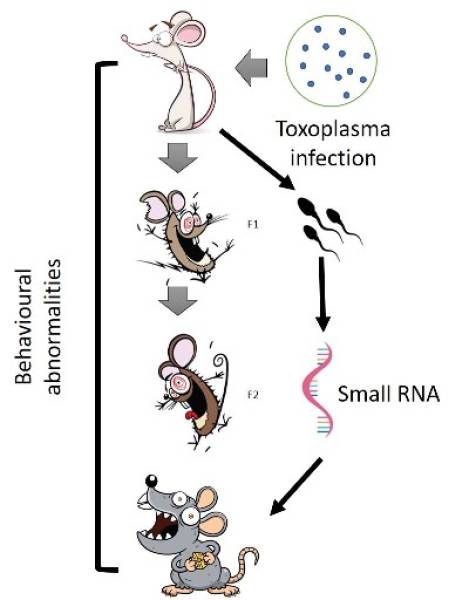
The Inheritance You Did Not Ask For
The researcher provides evidence that paternal pathogenic infection has transgenerational impacts on offspring phenotypes. They discover that Toxoplasma gondii infection induces epigenetic changes, involving small RNAs, in mouse sperm, and demonstrate a mechanism involving these non-coding RNAs.
Inherited small RNA: The inheritance you did not ask for
Source
- The University of Melbourne and The Walter and Eliza Hall Institute of Medical Research
Highlights
- Toxoplasma gondi infection results in behavioral and cognitive abnormalities that are inherited by at least two succeeding generations.
- The infection causes a change in Sperm small RNA but quantitively and qualitatively.
- Microinjection with the sperm small RNA isolated from infected mice can recreate similar behavioral changes.

There is an old proverb which says, “Every inheritance may not be a blessing”. You may feel proud of your mesmerizing eye colour inherited from your mother, or that cute cheek on your dimple just like your dad, but every heredity may not sound like a wish to come true. These heredities can both be a genetically imprinted phenotype or an environmentally induced trait passed across generations. But what about a behavioural change acquired during a parasitic infection? Can that be passed on to the next generation?
A group of scientists from Australia had discovered a paternal inheritance of the cognitive and behavioural changes due to Toxoplasma gondi infection across generations. Toxoplasma infection causes a significant amount of sexual, neurobiological, and cognitive changes in an infected animal by reprogramming the host epigenetic profile.
Heredity of infection
Using mice as a model organism, they compared few neuropsychiatric traits of offspring from the first generation of infected and uninfected male mice and discovered that cognitive traits such as anxiety and depression-like phenotype, social recognition memory are greatly affected in infected parental offspring compared to the uninfected subject. Not only that, but they also found the traits to be evidently altered in male progeny (F1) compared to female ones. The similar behavioural abnormalities were observed in mice from the succeeding (F2) generation, proving this effect not only to be only intergenerational, but transgenerational.
The mechanism
While searching for the mechanism behind this phenomenon, they found a significant amount of change in global RNA, specifically small RNA profiles of sperm cells. As per the report, the sperm small RNA profile of male mice form both F1 and F2 generations are altered qualitatively and quantitively.
The researcher landed upon their most interesting finding when the injected the sperm small RNA from an infected mouse to developing oocyte and were able to reshape the zygotic development and epigenetic environment resulting in neuropsychiatric alterations.
The future prospect of the research
Toxoplasma, one of the most successful pathogens was proven to leave a genetic imprint that was transgenerationally forwarded. This leaves us with the question if genetic and epigenetic changes due to other infections, environmental factors, habits, or trauma could be considered as a hereditary trait. Currently, the researchers are expanding their spectrum of animal models to humans and pathogens such as the SARS-CoV-2 virus.
Journal reference
- Cell Reports. DOI: 10.1016/j.celrep.2020.107573
